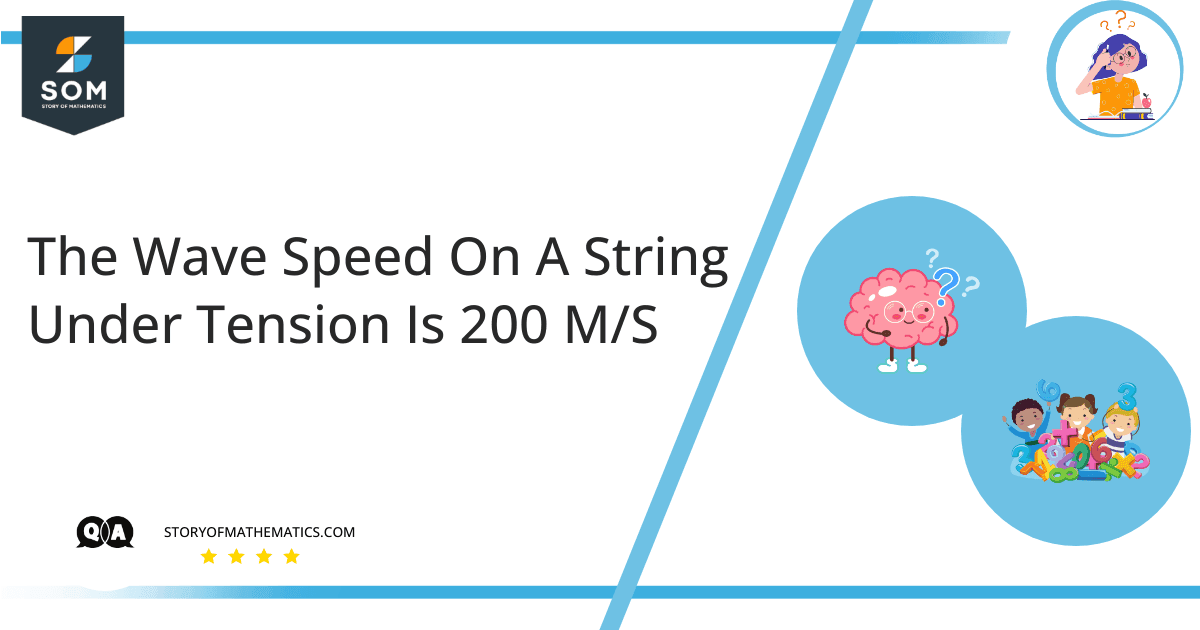
The aim of this question is to understand the key concepts of speed, frequency, wavelength, and tension in a string.
Whenever energy is transferred from one place to another through the successive vibratory motion of particles, this form of energy transferring agent is called a wave. All type of waves have some common properties such as the speed, frequency, wavelength etc.
The speed of a wave traveling through a string depends upon its tension $ F_{ T } $, mass of the string $ m $, and the length of the string $ L $. Given these parameters, it can be calculated using the following formula:
\[ v_{ wave } \ = \ \sqrt{ \dfrac{ F_{ T } \times L }{ m } } \]
Expert Answer:
Lets say:
\[ \text{ speed of wave at original tension } \ = \ v_{ wave } \ = \ \sqrt{ \dfrac{ F_{ T } \times L }{ m } } \]
\[ \text{ speed of wave at doubled tension } \ = \ v’_{ wave } \ = \ \sqrt{ \dfrac{ 2 \times F_{ T } \times L }{ m } } \]
Notice that both $ L $ and $ m $ remain the same because they are the property of the string, which is not changed. Dividing both of the above equations:
\[ \dfrac{ v’_{ wave } }{ v_{ wave } } \ = \ \dfrac{ \sqrt{ \dfrac{ 2 \times F_{ T } \times L }{ m } } }{ \sqrt{ \dfrac{ F_{ T } \times L }{ m } } } \]
\[ \Rightarrow \dfrac{ v’_{ wave } }{ v_{ wave } } \ = \ \sqrt{ \dfrac{ 2 \times F_{ T } \times L \times m }{ F_{ T } \times L \times m } } \]
\[ \Rightarrow \dfrac{ v’_{ wave } }{ v_{ wave } } \ = \ \sqrt{ 2 } \]
\[ \Rightarrow v’_{ wave } \ = \ \sqrt{ 2 } v_{ wave } \ … \ … \ … \ … \ ( 1 ) \]
Substituting values:
\[ \Rightarrow v’_{ wave } \ = \ \sqrt{ 2 } ( 200 \ m/s ) \]
\[ \Rightarrow v’_{ wave } \ = \ 280 \ m/s \]
Which is the required answer.
Numerical Result
\[ \Rightarrow v’_{ wave } \ = \ 280 \ m/s \]
Example
What happens to the speed of the wave if the tension in the string is raised by four times instead of doubling?
Lets say:
\[ \text{ speed of wave at original tension } \ = \ v_{ wave } \ = \ \sqrt{ \dfrac{ F_{ T } \times L }{ m } } \]
\[ \text{ speed of wave at four times the tension } \ = \ v’_{ wave } \ = \ \sqrt{ \dfrac{ 4 \times F_{ T } \times L }{ m } } \]
Dividing both of the above equations:
\[ \dfrac{ v’_{ wave } }{ v_{ wave } } \ = \ \dfrac{ \sqrt{ \dfrac{ 4 \times F_{ T } \times L }{ m } } }{ \sqrt{ \dfrac{ F_{ T } \times L }{ m } } } \]
\[ \Rightarrow \dfrac{ v’_{ wave } }{ v_{ wave } } \ = \ \sqrt{ \dfrac{ 4 \times F_{ T } \times L \times m }{ F_{ T } \times L \times m } } \]
\[ \Rightarrow \dfrac{ v’_{ wave } }{ v_{ wave } } \ = \ \sqrt{ 4 } \]
\[ \Rightarrow \dfrac{ v’_{ wave } }{ v_{ wave } } \ = \ 2 \]
\[ \Rightarrow v’_{ wave } \ = \ 2 v_{ wave } \ … \ … \ … \ … \ ( 2 ) \]
Substituting values:
\[ \Rightarrow v’_{ wave } \ = \ 2 ( 200 \ m/s ) \]
\[ \Rightarrow v’_{ wave } \ = \ 400 \ m/s \]
